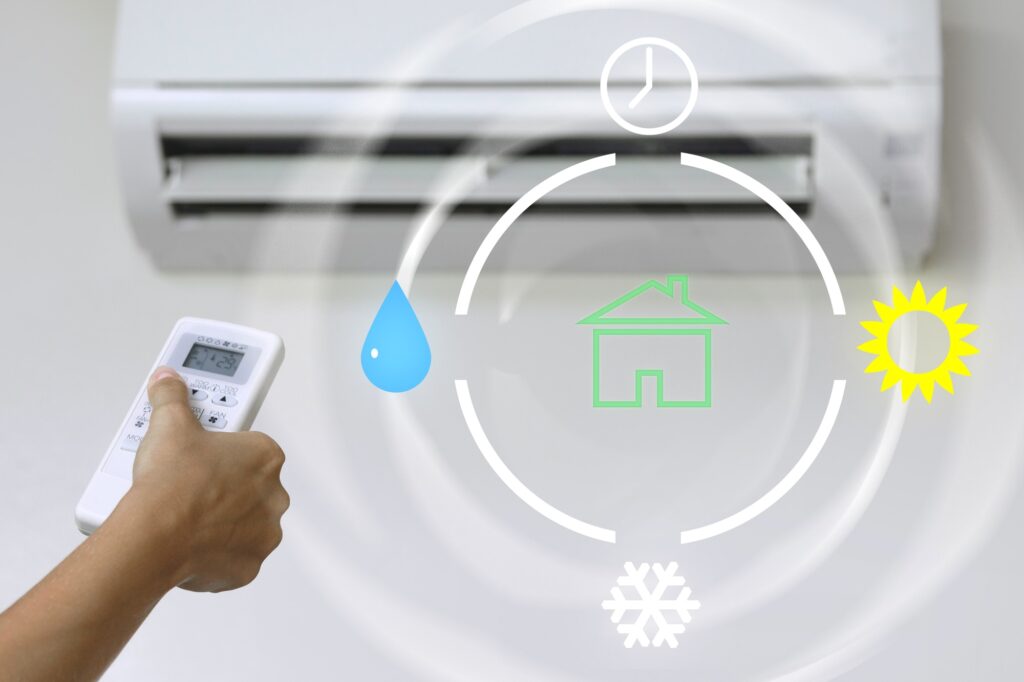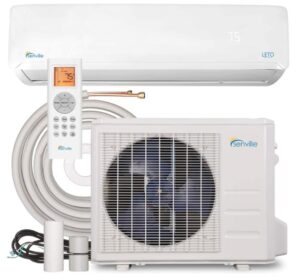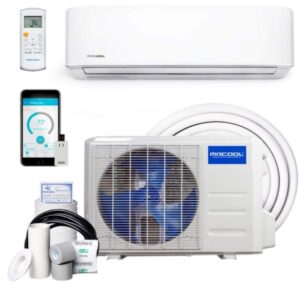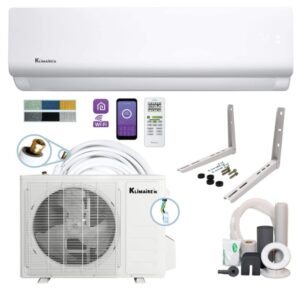
In the last few years, heat pump technology has improved a lot. Even though mini-split heat pumps are still fairly expensive, they have improved a lot since their first appearance in the late 90s and have become much more efficient.
A mini-split heat pump is a type of air-source heat pump that does not require ductwork to distribute the heated air. This makes them perfect for small homes, apartments, or other areas without ductwork installed already.
There are many factors to consider when reviewing heat pumps, and there are many models, I decided to gather some of the most up-to-date information from various sources, and put it together in one place to help those who might find themselves considering installing a mini-split heat pump for their home!
Table of Contents
What Is a Mini Split Heat Pump?
Mini-split heat pumps are a type of HVAC (heating, ventilation, air conditioning) system that uses an outdoor compressor with an indoor evaporator coil to heat and cool the air.
It’s a great alternative to gas-fired systems for people looking for efficiency without having to pay for the additional costs of natural gas.
The main difference between a conventional furnace or air conditioner and a mini-split heat pump is that the system is smaller and with lesser parts to maintain.
Advantages & Disadvantages of Mini Split Heat Pump
Advantages
1) Mini-split systems are quieter than traditional heat pump systems
Mini-split systems are the most popular HVAC systems in the United States. They are quieter than traditional heat pump systems.
The main reason for this is that mini-split systems use an indoor fan to circulate air inside the home, while traditional heat pump systems use an outdoor fan to do so. This means that they produce less noise and vibration on the inside of your home.
2) Mini-split units have fewer moving parts than standard split units.
As opposed to traditional heat pump systems units that require electrical wiring and motors in order to work properly, mini-split units needs less wiring than standard split unit. This not only makes them easier to repair but also means they are much less likely to break down or fail over time; fewer costly repairs mean more money in your pocket.
3) Mini-split heat pumps can help increase space efficiency and save valuable energy.
Because they are smaller and require less energy, mini-split heat pumps are more efficient at heating and cooling air in a home than a furnace would be. This means that you could potentially save a lot of energy by using a mini-split heat pump instead of a traditional furnace.
Disadvantages
1) Mini-split systems are more expensive to install than traditional units.
Mini-split units are more expensive to buy than traditional units. A professional installation is recommended because some features, such as thermostat programming and maintenance are complex to use if you only have a novice knowledge of HVAC.
Many homeowners are considering DIY instead of hiring a professional due to the installation costs, which range from $1000-$2000.
*Please check your warranty period and coverage before installing it yourself.
2) Mini-split systems do not distribute the air evenly.
Because mini-split systems do not use ductwork, they do not distribute the air evenly throughout the home. Mini-split units do not use ducts to circulate the heated air around the home, which means they do not distribute the air evenly throughout the house. This means that you will need to install multiple units in order to cover the entire space that you want to heat or cool.
What is A Good SEER/HSPF Rating For A Mini-split heat Pump?
The SEER (Seasonal Energy Efficiency Ratio) rating is an index that represents the cooling efficiency of a cooling system over the course of an entire season. The higher the SEER rating, the more efficient the system will be.
The HSPF (Heating Seasonal Performance Factor) rating is an index that represents the heating efficiency of a heating system over the course of an entire season. The higher the HSPF, the more efficient the system will be.
Energy efficiency is measured in SEER and HSPF. The SEER or HSPF rating tells you how much energy your heat pump will use during the heating and cooling seasons. The higher the SEER or HSPF rating, the more efficient the unit will be.
The higher the SEER or HSPF rating, the less energy will be used to heat or cool your home. The lower the SEER or HSPF rating, the more energy will be used.
SEER and HSPF are two different ratings. The SEER rating is the average cooling efficiency of the unit over the course of a single year. The HSPF rating is the average heating efficiency of the unit over the course of a single year.
What to Consider When Choosing the Best Heat Pump?
Bearing in mind the terms discussed above and reading through this list of crucial factors will give you more well-rounded knowledge when it comes to choosing a heat pump:
Budget:
Prioritize your budget by considering what percentage of heating and cooling duty cycle you prefer (for example, if handling hot or cold weather), as to how long it’ll be until the unit needs servicing. Choosing an aperture is also important because airflow rates are different depending on what direction the unit is facing.
Size:
Make sure you choose a heat pump that can fit in your home no matter where it needs to be placed. Find the right size to fit your living space and your energy budget.
Energy Efficient:
Choose a ductless mini-split system that’s designed to be more energy-efficient than the standard models. This will result in lower energy consumption during heating and cooling seasons combined with increased comfort & occupant experience (performance).
*The Energy Star program was created to help consumers make informed decisions about energy efficient products. It’s a voluntary program that encourages manufacturers to improve products that meet certain energy efficiency criteria. You can find out if a product is Energy Star certified here.
Use the energy star rating system that helps you with your energy audit. Basically, it’s a ranking system to help consumers decide which heat pump to buy. The higher the SEER or HSPF rating, the more efficient a unit will be. Look for units that have identical ratings to ensure maximum efficiency (and thus savings) over time.
Ease of Maintenance:
A heat pump that’s difficult to work on will not last as long and may require service or warranty repairs if you want it repaired when a problem develops. Certain manufacturers for certain products lack the same risk-free lifetime guarantee given by others who specialize in specific mechanical components due to their specialized knowledge.
Output Capacity:
The total capacity of a heat pump is measured in BTU/Hr (British Thermal Units per hour). The higher the BTU/Hr rating, the more BTUs the unit can produce. Generally, a higher BTU/Hr rating means that your unit will be able to heat or cool more efficiently.
When looking at the heat pump’s output capacity, you should also consider the size of your home and the amount of time you need your unit to provide you with comfort and efficiency.
In general, the higher output capacity achieved by a unit is dependent on compressor size. You can make use of this BTU calculator to determine the sizing of your mini split.
Noise Level:
You should consider how much noise the unit will make when it’s operating and if it’s important to you.
Higher-quality heat pumps will have a lower noise level than standard heat pumps. Noise levels range from 35-50 decibels.
A quieter unit will make you and your family feel more comfortable, especially if it’s located in a bedroom or other area where you want to sleep.
Our Top Picks
- 7.7 HSPF is the minimum.
- 8.5 HSPF is a good HSPF rating (earns an ENERGY STAR label).
SEER 16 is a good SEER rating for an air conditioner. Anything above that – SEER 18, SEER 20 – is great.
We recommend these units for their energy efficiency, ease of maintenance, and quiet operation.
Senville LETO Series Mini Split Air Conditioner Heat Pump (SENL-24CD/X)

HSPF(HEAT) RATING and CAPACITY: 9.5HSPF & 25,000 BTU/h Heating Capacity
SEER(COOL) RATING and CAPACITY: 17.5SEER and 24500 BTU/h Cooling Capacity
Air Flow Efficiency: 706 Cubic Feet Per Minute Per Watt
Noise Level: 48/42.5/34dB (HI/MID/LOW)
The Senville LETO series is a mini-split heat pump system that provides you with cooling, heating, dehumidifier, fan, and turbo functions.
Senville LETO series delivers superior performance, efficiency, and reliability at a budget-friendly price. With a good rating of HSPF 9.5 and SEER 17.5, you can rely on the Senville LETO with their 5-year manufacturer warranty with additional free technical & installation support.
The LETO series performed exceptionally well in the tests of both system performance and noise level (Low 34dB), proving its worth as an affordable solution for a clean, comfortable home.
PROS: Quiet with barely any rumbling noise, tech support was friendly and helpful, comes with 6 variations from 9000BTU- 30000BTU
CONS: Cant DIY Requires Professional Installation.
See price of Senville LETO on Amazon here.
MRCOOL 3rd Generation Enhanced DIY (DIY-24-HP-230B)

HSPF(HEAT) RATING and CAPACITY: 10HSPF & 25,000 BTU
SEER(COOL) RATING and CAPACITY: 20SEER & 23,000 BTU
Air Flow Efficiency: –
Noise Level: 47/42/33.5dB (HI/MID/LOW)
MRCOOL E Star DIY 3rd Gen 24k BTU 20 SEER Ductless Mini-Split Heat Pump is what I would get for my home, 1000 square feet will not be an issue for this smart mini-split heat pump that connects with your wi-fi for easy setup and a clean user interface for easy controls. It isn’t hard to install it as well with clear step-by-step instructions and an installation kit.
I would recommend this mini split because it is not only versatile but also affordable, easy on the eyes due to its modern design, great quality components within its package along with superb tech support especially when ordering parts online.
PROS: Supports Google Assistant & Amazon Alexa, easy DIY installation, smartphone app control, simple and stylish design, indoor and outdoor units are quiet.
CONS: Quite pricy compared to other similar range brands, occasional issues with the app, temperature sensor not accurate.
See price of MRCOOL 3rd Gen on Amazon here.
KLIMAIRE “Do-it-Yourself” Mini Split A/C Heat Pump system. (KIWQ18H2 + KOIQ18H2)

HSPF(HEAT) RATING and CAPACITY: 10 HSPF & 19,000 BTU
SEER(COOL) RATING and CAPACITY: 19 SEER & 18,000 BTU
Air Flow Efficiency: 1030 Cubic Meters / Hour
Noise Level: 44/39/34dB (HI/MID/LOW)
KLIMAIRE “Do-it-Yourself” Mini Split A/C Heat Pump system will be good for those who want to install it themselves without much hassle and with their new i-feel is a built-in temperature sensor that senses the temperature around the remote control to cool or heat the user, it’s part of the Smart Life App that allows you to control many features.
They included a Self-Clean feature that improves the air quality!
These will come with the purchase:
- Outdoor Heat Pump Condenser
- Indoor Wall Mounted Air Handler
- 25 ft. Pre-Charged Quick Connect Refrigerant Line Set
- Easy plug-in Interconnecting Wire Cable
- I Feel Remote Control with Wall Bracket Holder
- A set of Healthy Filters
- Remote Control with Wall Bracket Holder
- Built-in Wi-Fi Smart Life App
- Installation Kit Accessories
- Heavy Duty Outdoor Unit Wall Mounting Bracket
See price of KLIMAIRE on Amazon here.

